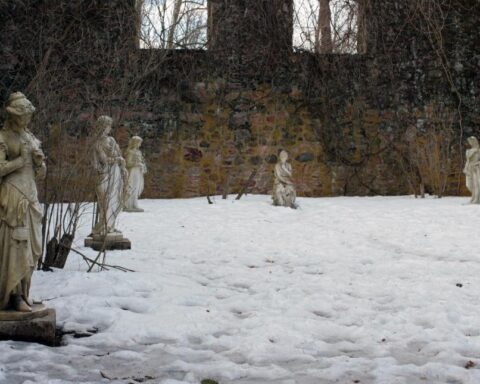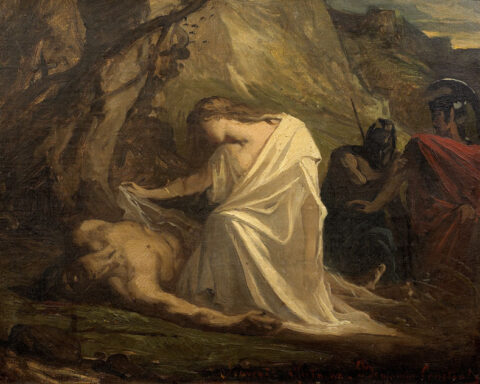Oddly, it wasn’t the body lying rag-doll soft in the base of the fountain, one hand still propped on the edge, that held the attention of the two police officers; it was the fountain itself. It was the way the whole thing shone in the sunlight, the way the fractured tiles and bits of gemstone colored glass were washed with the return of the far-flung drops of water that compelled the team (one man, one women, each in uniform and properly armed) to catch what seemed to be a mutual breath, holding in the air as if to make sure the moment had stopped, to ensure that everything would stand still long enough to allow the time necessary to take it all in. All of it: the water returning from its 10 meter flight; the glass broken into as many different shapes as could be imagined – a veritable snowflake array of shapes and sizes; the fantastic form of the central figure – a dragon in flight? a woman with a windblown cape?; the basin lined with dozens of shades of red glass – the color of rubies, pomegranates, of the American Beauty rose, all pieced together to make a red so deep, so complex you could stare into it and still never quite know where the bottom lay. And then, of course, there were the tiles. Although the glass was what was immediately noticeable, breaking the least suggestion of sun into a thousand splinters so that the whole structure seemed lit from within, the tiles, too, deserved attention. No generic Reno-depot tiles were these, no Home Hardware special of the week; these tiles were something else entirely. These tiles had come from all over the world: the lapis lazuli of Persia, the malachite greens of Mexico, Defltware blues, and the browns and golds of the Arts and Crafts movement – all of it shattered and then reordered, reimagined, recreated. And last all – most important of all according to the experts from the museum – were the brilliantly colored tiles constructed and painted by Eugenia Harris herself. These, too, had been shattered and split before she had strewn the bits, used those tiny fragments to create entirely different images, interspersed the pieces across the mosaic that covered the fountain in which she died.
But standing there that day, death was barely noticeable. It was only after the two officers finally managed to pull their attention away from the fountain itself that they saw her, and even then they were almost too distracted to notice the details: the way she lay swaying like a mermaid, the water washing features that appeared much gentler than they ever had in life.
Anyone who knew Eugenia Harris could tell you that the gentle brow, the relaxed mouth were no more this woman’s daily face than the softly cupped and upturned palm rocking with the movement of the water was the shape most familiar to that hand. No. It was the hand still propped on the rim clenched tight and holding fast that was much more like the Eugenia who had been praised and castigated by any number of art critics, the Eugenia who had met every bad review and nasty quip with an equally scathing and – likely – more erudite commentary that made the guilty party think twice before biting the hand that was most certainly going to offer a slap in response. Indeed, it was that closed fist, gripped tight, that was much more expressive of the woman the world had experienced, the Eugenia who had never been one to give anything away. But the officers didn’t know that the posture of this body was unusual, and if they had, they likely wouldn’t have cared. Even after calling for the detectives and the coroner, the body lost their attention, and while waiting for the forensic squad with their plastic gloves, multi-sized containers and eye for the detail no one else saw – even with the body immediately to hand, it was still the fountain that held their attention. And so they stood, unmoving even as the sirens announced the rest of the players that were to close the curtain on this particular drama; it was enough to make anyone wonder just what it was the two saw.
Certainly, the experts – museum curators, a PhD candidate who was specializing in the work of Eugenia Harris, and all the other art historians who would study the fountain for years to come – all of those specialists would see something very different from whatever it was that held the attention of the two officers on that day as they stood in the sunshine gazing at that amazing cathedral of water and light. If asked, the experts would argue that the two couldn’t understand what it was that they were looking at as they stared up, breath caught, heads tilted back in order to take in everything before them. The PhD candidate would later write about how the important information the fountain offered could only be deciphered through a reconstruction of the detail, that the information that mattered was picked out, outlined, and shaded onto Eugenia’s handmade tiles that had then been shattered, the fragments embedded on disparate portions of the fountain. He would mourn over the fact that without physically deconstructing the structure, it was all but impossible to find and reorder the tiny portions of the tiles on which existed those masterfully captured images. Even though that brilliant young man was to spend three years longer than planned gaining his degree because of this new wealth of information, three years attempting to decode the images hidden in plain sight, he would never be able to recreate more than a few of them, all scattered across the surface of that masterpiece. He would only ever find a handful. But he would find a few.
Yes, he will find a few. Perhaps because he already knows particular moments exist, and he is very persistent and has diligently studied his subject, the brilliant student will bring to light a number of the images spattered across the fountain, specifically those that capture the moments of Eugenia Harris’ success. After months of work, the PhD student will find the image of champagne glasses and swirling crowds. He will discover the depiction of the tiled front of the concert hall for which Eugenia Harris was catapulted into world renown. He will piece together a fair number of images all concerned with glowing moments and adulation. He will write about how the fountain is a monument to Eugenia’s achievements. And perhaps it is . . . in a way. What he will tuck away in a footnote is the one image he has found but cannot understand. He will never have more than a disturbing guess about the self-portrait: Eugenia herself being devoured in gory detail by what appears to be a medieval depiction of Satan – blood and guts worthy of an illustration in a Puritan’s bible. But because he can’t understand, can’t know the implications, he will choose to make only a brief side-note about it, and that inability to understand will rankle and gnaw at him for years. But his confusion is not surprising; the tile’s place is with the other images, the ones that he will miss.
In fact, despite the limitations the experts will assume as the inevitable lot of the casual observer (specifically in this case, the two officers), not one of those highly learned specialists will ever find most of those other images. No one will ever see the tile depicting with scathing contempt and tragic poignancy the portrait of a mother caught arms uplifted in fear and faith – praising God? praising a husband who always kept a belt to hand despite his preference for suspenders? And as well, no matter how many attempts to coalesce the pieces, not a soul will ever find the tile that shows a father, a husband, arm raised, eyes full of dread and doom, caught in the full understanding that some actions create destiny, that for certain choices there is only one possible outcome. And no one will ever gaze on the images of needles, white powder, and poverty, on closed doors, on desperate and shabby hideouts that fail to offer refuge. No one will find the image of a dead infant – a baby girl, hair as soft and pale as Eugenia’s own. Except for that inexplicable single tile found by the brilliant boy, no one will ever find the images that depict the monsters and demons that reside nowhere else but in Eugenia Harris’ head. Certainly the two police officers never will.
But undiscovered tiles or not, the world will know that, concerning Eugenia Harris, there are unanswered questions. Not about her death. The cryptic message the artist left on her agent’s voice mail, her complete lack of response regarding the neighbors’ complaints about the noise the construction had created – noise that often continued into the small hours – her complete immersion in finishing this final work, and finally, the diagnosis of Alzheimer’s that the doctor will communicate to the investigators: all of it makes clear that the death was a choice rather than inflicted. No. The question isn’t how she died or who is the cause; rather, the question that even the student cannot choose to hide or belittle is left behind gripped in that hand still propped on the edge of the fountain, that piece of tile so different from all the rest. Wrapped in her fist so tightly that there are permanent impressions in the flesh and the coroner must break the bones of the fingers that surround the fragment in order to set it free is the image of a sun; rayed and dazzling it shines, relentless and with joy.
The responding officers will never get a chance to see that fragment of tile. They will have been chastised for their inefficiency, debriefed and sent on their way by the detectives who replace them at the scene. They will never see most of the details, whether those details are in the realm of the law or academia. Still, even without a chance to finger that portion of tile, even though neither will ever wonder about the meaning of that sun, in a way, they will understand. Each, for the rest of his or her life, will remember the ten minutes they stood together on the plateau at the top of Eugenia Harris’ lawn staring at that epiphany, that chimera – that self-portrait. In fact, perhaps all the specialists are wrong about what those two stalwarts saw or failed to see. Standing there in the liquid light of the fountain, their faces colored with reflections like devotees in a stain glass sanctuary, perhaps they saw it all; perhaps they saw exactly what was there to be seen.



